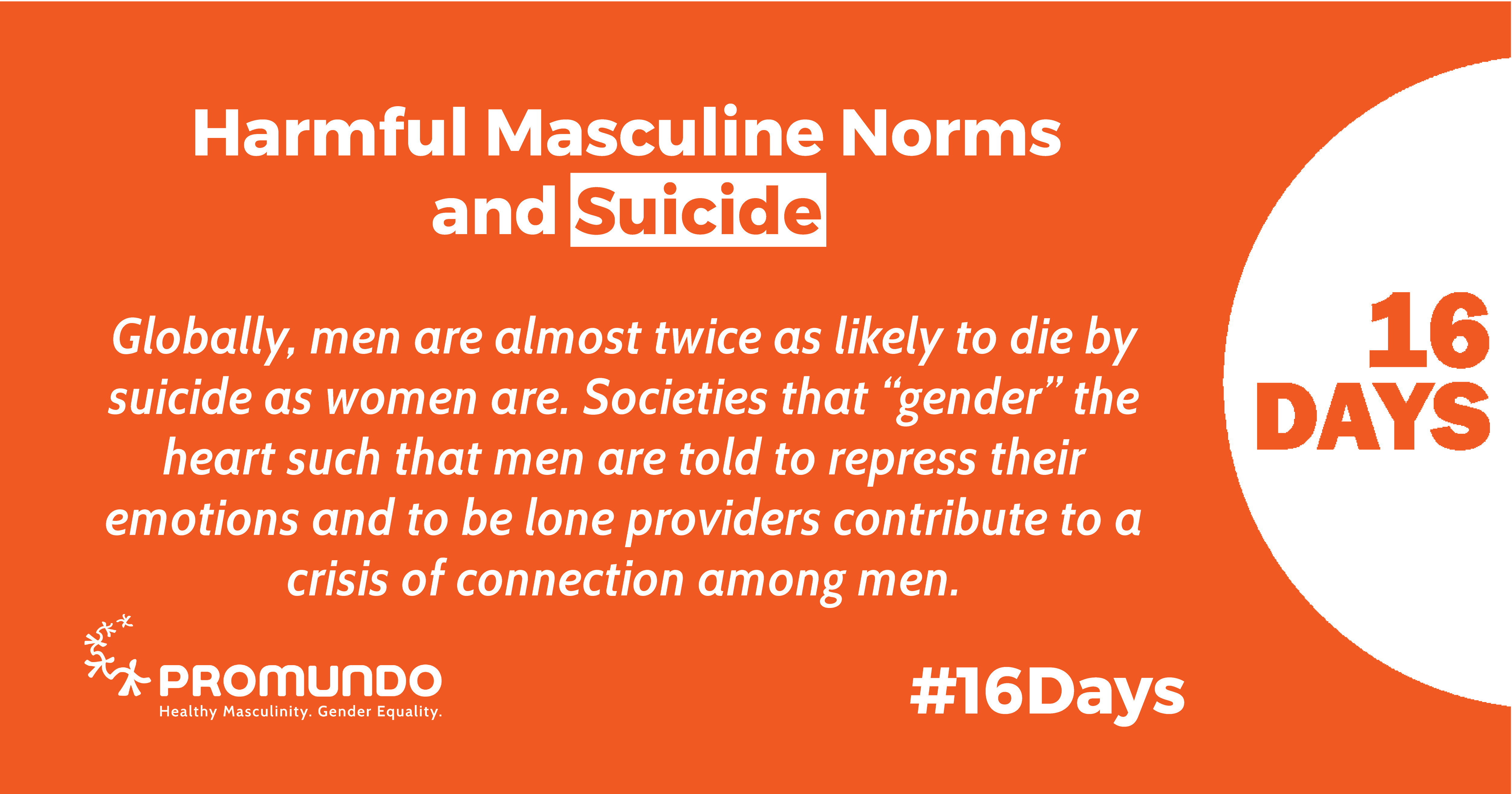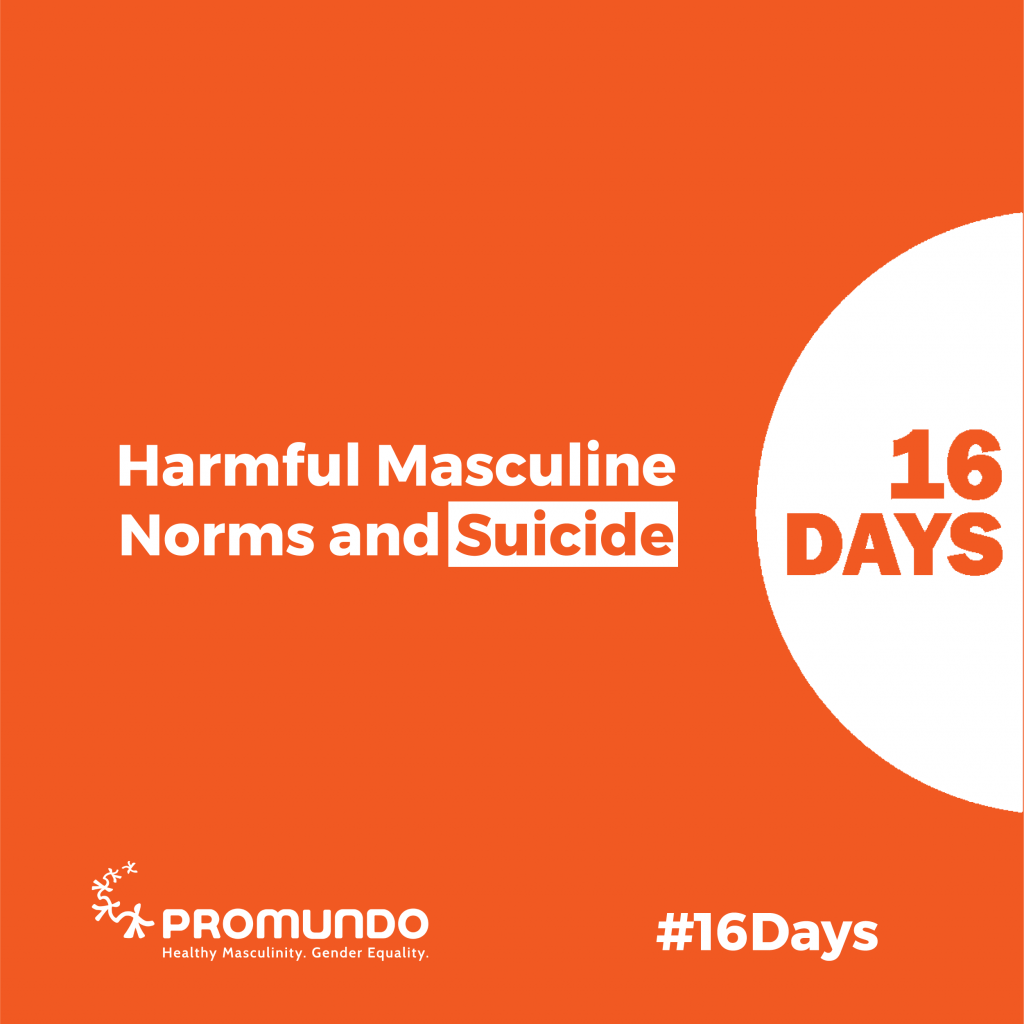Les 16 jours d’activisme contre la violence sexiste sont une campagne internationale utilisée par des militants du monde entier (du 25 novembre au 10 décembre) comme stratégie d’organisation pour appeler à l’élimination de toutes les formes de violence sexiste.
Cette année, nous partagerons des recherches sur les liens entre les normes masculines néfastes et huit formes différentes de comportement violent, ainsi que des idées et des recommandations pour éliminer toutes les formes de violence.

Même si le fait d’être un homme n’a rien d’inhérent à la violence, la manière dont nous socialisons les garçons dans leur identité d’homme et ce que nous attendons d’eux – c’est-à-dire les normes masculines de la société – sont indéniablement liés à la violence.
En effet, les garçons et les hommes sont souvent élevés, socialisés et encouragés à recourir à la violence sous une forme ou une autre ; dans l’ensemble, ils sont plus susceptibles de commettre la plupart des formes de violence et de mourir par homicide ou suicide. Cependant, les recherches confirment que cette violence est évitable, que l’égalité des sexes est réalisable et que les normes et idées non violentes sur la virilité sont répandues et puissantes.
Rapport d'Equimundo et de la Fondation Oak Normes masculines et violence : établir des liens, examines the links between harmful masculine norms and eight forms of violent behavior. This seventh blog in the Établir les connexions16 jours d'activisme series focuses on suicide. It breaks down the facts on this issue, explores the links between suicide and other forms of violence, and provides recommendations for action.
Suicide
Les faits
Globally, men are almost twice as likely to die by suicide as women are, with the World Health Organization (WHO) estimating that 15 men per 100,000 and eight women per 100,000 die by suicide on average, with tremendous variation by country.
While suicide is often not considered violence, 50 percent of all violent deaths for men are suicides. While women are more likely to attempt suicide, men are more likely to die by suicide.
Les liens
Des normes de genre néfastes peuvent souvent être à l'origine d'idées suicidaires et de suicides. Les sociétés qui «genrent» le cœur, de telle sorte que les hommes sont invités à se couper de leur vie intérieure, à réprimer leurs émotions et à devenir des travailleurs acharnés, des protecteurs et des pourvoyeurs solitaires, contribuent à une crise de connexion Parmi les hommes, plusieurs chercheurs soulignent l'alexithymie – l'incapacité à se connecter à ses émotions et à les communiquer – comme un signe précurseur particulièrement masculin des idées suicidaires.
Failure to fulfill the socially prescribed role of financial provider can drive some men in the direction of self-harm and suicide. When men are taught to be self-sufficient and independent at all costs, they may be averse to seeking mental health services, and this aversion is also linked with suicidal behavior.
L’acte de suicide peut également être construit comme une action masculine ou masculinisée, ce qui peut expliquer pourquoi les hommes sont plus susceptibles d’utiliser des moyens immédiatement mortels tels que les armes à feu lorsqu’ils tentent de se suicider.
Tous ces liens conceptuels sont en outre étayés par des données empiriques reliant une plus grande adhésion à des normes masculines néfastes – que ce soit par des hommes individuellement ou telles qu’exprimées dans la culture dominante – à une augmentation des comportements suicidaires chez les hommes. La boîte à hommes study, young men in the United States, United Kingdom, and Mexico who most strongly agreed with harmful masculine norms – such as being tough, aggressive, controlling, and self-sufficient – were also significantly more likely to report suicidal ideation in the previous two weeks than young men who rejected those norms.
Research also shows that harmful masculine norms linked with sexual identity – particularly heteronormative and homophobic notions – are associated with increased mental health challenges and suicide risk among individuals who identify as lesbian, gay, bisexual, transgender, intersex, or genderqueer.
Les intersections
Research on the risk factors for suicide is limited, but data suggest these risk factors include financial stress, mental health issues, alcohol abuse, and physical health issues associated with chronic pain.
Additionally, differential male-to-female suicide ratios across the globe suggest that cultural context, employment patterns and income inequality, race, ethnicity, and other demographic factors intersect with gender norms to influence suicidal ideation and behaviors.
“Gendering” of the heart and men’s cultivated emotional isolation often mean that men are unlikely to pursue formal healthcare or even to seek help and support from family and friends when they need it. However, access to adequate healthcare, support services, and social support from family, friends, and neighbors are particularly essential in curbing men’s suicidal ideation and behavior.
De la théorie à la pratique
There is increasing interest in the use of approaches to address harmful gender norms in the field of suicide prevention, but most of these initiatives are new and their geographic range is limited. Initiatives aiming to prevent suicide should focus on the following transformations of harmful masculine norms:
- Identifiez et discutez de la manière dont les masculinités normatives « genrent » le cœur, suppriment l’expression émotionnelle et peuvent conduire à un sentiment de déconnexion, d’isolement et de détresse.
- Provide spaces for men and boys to express emotions, bond with peers, and build a sense of community and belonging.
- Engage participants in discussions on traditional gender norms, the pressures of achieving manhood, and the intense – and often unrealistic – expectations both place on men and boys.
- Encourage and legitimize help-seeking behavior – including mental health care – among men and boys.
- Explorer et valider des formes alternatives non violentes de masculinité.
